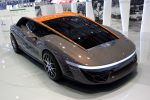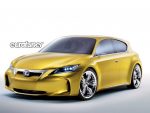The Concept Car: A Platform for Innovation
Concept cars are more than just flashy prototypes; they serve as a platform for innovation within the automotive industry. These vehicles allow designers and manufacturers to showcase cutting-edge styling, technology, and ideas that push the boundaries of what is possible in the automotive world.
At motor shows like the Tokyo Auto Show, concept cars are put on display to gauge customer reactions and gather feedback before any decisions are made about mass production. This allows companies to take into account the preferences and desires of potential consumers before moving forward with new designs or features.
While concept cars may not be intended for immediate production, they often evolve into production-intent prototypes that incorporate necessary modifications for practicality, safety, regulatory compliance, and cost considerations. This means that the futuristic features and designs showcased in concept cars have a real impact on the vehicles that eventually make it to market.
In fact, concept cars have a significant impact on the automotive industry as a whole. They drive innovation by pushing the boundaries of what is possible in terms of design and technology. This influence can be seen in the evolution of concept cars over time, as they continue to showcase radical design and engineering advancements that ultimately shape the future of mobility Future Automotive Innovation Mazda.
For car enthusiasts and industry professionals alike, concept cars offer a glimpse into what the future of transportation might look like. They represent the potential for groundbreaking advancements in safety, efficiency, and overall driving experience. As such, they continue to capture the imagination of automotive enthusiasts around the world.

The Evolution of Concept Cars
The concept car has come a long way since its inception, thanks to the influence of General Motors designer Harley Earl and his Motorama shows in the 1950s. These events were instrumental in popularizing the concept car and showcasing the potential for innovation in the automotive industry.
With the passage of time, concept cars have evolved into much more than just flashy prototypes. They have become a platform for pushing the boundaries of design and technology, often serving as a glimpse into the future of mobility. The impact of concept cars on the automotive industry cannot be overstated, as they continue to inspire and shape the development of production vehicles.
Concept Cars: A Historical Perspective
Harley Earl’s Motorama shows introduced audiences to futuristic concept cars that were far ahead of their time. These early prototypes featured radical designs and innovative technologies that captured the imagination of car enthusiasts and industry professionals alike. The success of these events paved the way for other automakers to follow suit, leading to the proliferation of concept cars as a staple in the automotive landscape.
Notable Examples of Concept Cars
Over the years, there have been many notable examples of concept cars that have left a lasting impression on both consumers and industry insiders. From the sleek and futuristic Chevrolet Corvette Stingray Concept to the groundbreaking and environmentally-friendly Chevrolet Volt, these prototypes have demonstrated the potential for innovation in design, engineering, and technology.
Concept Cars Today
In today’s automotive industry, concept cars continue to play a significant role in shaping the future of mobility. With a focus on sustainability, connectivity, and autonomous driving capabilities, modern concept cars are at the forefront of innovation. They serve as a platform for showcasing advanced technologies and visionary design concepts that influence the development of production vehicles Top SUV Vehicles.
The evolution of concept cars reflects a commitment to pushing boundaries and embracing innovation in an ever-changing industry. As automakers continue to invest in research and development, we can expect to see even more groundbreaking concept cars that redefine our expectations for the future of mobility.

Tokyo Auto Show: Showcasing Future Mobility
The Tokyo Auto Show has long been a hotbed for innovation and forward-thinking concepts in the automotive industry. This annual event provides a platform for major automotive companies to unveil cutting-edge concept cars that showcase the future of electric mobility and performance. The 2023 Tokyo Auto Show was no exception, featuring a range of innovative concepts that have garnered significant attention for their futuristic designs and potential impact on the automotive industry.
Unveiling Cutting-Edge Concepts
At the 2023 Tokyo Auto Show, major automotive companies showcased their latest concept cars, including Toyota’s FT-Se and Mazda’s Iconic SP. These concept cars have been turning heads with their radical designs and innovative engineering, providing a glimpse into the future of mobility. The Major automotive mergers updates announcement has also become a major talking point within the industry, further highlighting the impact of these concept cars on the automotive landscape.
Future of Electric Mobility
One of the key highlights of the Tokyo Auto Show is its focus on electric mobility. With a growing emphasis on sustainability and environmental consciousness, many concept cars unveiled at the show have showcased advancements in electric technology, promising a cleaner and more efficient future for transportation. These developments are closely aligned with the broader shift towards electric vehicles within the automotive industry.
Impact on Automotive Industry
The concept cars unveiled at the Tokyo Auto Show are not just futuristic prototypes; they represent a driving force behind innovation within the automotive industry. By pushing boundaries in design, technology, and performance, these concept cars set new standards for what is possible in mobility. They inspire other automotive companies to continue pushing towards advancements in electric mobility and performance.
Conclusion
The Tokyo Auto Show continues to be a pivotal event for showcasing the potential future of mobility through innovative concept cars. As major automotive companies unveil their latest designs and technologies at this prestigious event, it becomes clear that the future of electric mobility is not just a possibility but an imminent reality. The impact of these cutting-edge concepts on the automotive industry is undeniable, setting the stage for a new era of sustainable and high-performance vehicles.

Radical Design and Engineering of Concept Cars
When it comes to concept cars, radical design and engineering are at the forefront of innovation. These vehicles push the boundaries of traditional automotive design, incorporating non-traditional materials, unique layouts, and special features that set them apart from production vehicles.
One prime example of this radical approach is the Mercedes-Benz Vision AVTR. This concept car allows drivers to operate certain features with their mind, integrating cutting-edge technology that blurs the line between driver and vehicle interaction. This futuristic approach to control and interface design showcases the innovative thinking behind concept cars.
Another notable example is the Fiat Centoventi, which takes customization to the next level. This concept car allows customers to personalize the vehicle’s color and design, giving them a unique level of control over the final product. This innovative approach to customization sets a new standard for consumer involvement in the design process.
The use of non-traditional materials is also a key aspect of radical design in concept cars. From advanced composites to sustainable resources, these materials allow for groundbreaking design choices that can influence future production vehicles. The integration of these materials not only showcases innovation but also highlights a commitment to sustainability and environmental consciousness within the automotive industry.
Overall, concept cars serve as a platform for pushing the boundaries of traditional automotive design and engineering. By embracing radical concepts and pushing technological boundaries, these vehicles pave the way for future innovations in the automotive industry.
To stay updated on the latest advancements in future automotive technologies, including electric vehicles, be sure to check out Electric vehicles tech news for all the latest developments in this rapidly evolving field.

The Impact of Concept Cars on the Automotive Industry
Concept cars have a significant impact on the automotive industry, influencing both consumers and manufacturers alike. These innovative and futuristic vehicles provide a glimpse into the future of mobility and technology, shaping the direction of the industry in various ways.
Driving Innovation
Concept cars are often at the forefront of technological advancements, showcasing cutting-edge features and designs that push the boundaries of what is currently possible. Manufacturers use these prototypes as a platform to experiment with new technologies, materials, and design concepts, ultimately driving innovation within the automotive sector. This continuous cycle of innovation helps to propel the industry forward, leading to the development of more advanced and efficient production models.
Influencing Production Models
The radical designs and engineering of concept cars often serve as inspiration for future production models. Manufacturers take cues from these prototypes, integrating elements such as unique styling, advanced infotainment systems, and innovative safety features into their mainstream vehicles. As a result, concept cars play a crucial role in shaping the overall direction of automotive design and technology, ultimately influencing the products that consumers have access to Car industry China.
Inspiring New Trends
Concept cars have the potential to inspire new trends within the automotive industry. Whether it’s through futuristic design elements, eco-friendly powertrains, or advanced connectivity features, these prototypes often set the stage for upcoming trends in consumer vehicles. By capturing the imagination of car enthusiasts and industry professionals alike, concept cars have the power to shift consumer preferences and drive demand for innovative technologies.
Attracting Customers
The unveiling of concept cars at major auto shows generates significant buzz and excitement among consumers. These prototypes serve as attention-grabbing showcases for manufacturers, attracting potential customers who are eager to experience the latest advancements in automotive technology. Furthermore, concept cars can generate valuable feedback from consumers, helping manufacturers gauge interest in new features and designs.
Overall Advancement of the Automotive Sector
In summary, concept cars play a vital role in advancing the automotive sector as a whole. From driving innovation and influencing production models to inspiring new trends and attracting customers, these prototypes have a far-reaching impact on the industry. By providing a glimpse into the future of mobility and technology, concept cars contribute to the ongoing evolution of the automotive landscape.
FAQ
What is the purpose of concept cars?
Concept cars serve as a platform for designers and manufacturers to showcase innovative styling, technology, and ideas, and gather feedback from customers before deciding whether to mass-produce them.
Who is credited with popularizing the concept car?
General motors designer harley earl is credited with popularizing the concept car through his motorama shows in the 1950s.
What are some examples of cutting-edge concept cars unveiled at recent auto shows?
Recent auto shows, such as the 2023 tokyo auto show, have featured innovative concepts like toyota’s ft-se and mazda’s iconic sp, which have garnered significant attention for their futuristic designs and potential impact on the automotive industry.
What are some unique features found in concept cars?
Concept cars can be radical in their design and engineering, incorporating non-traditional materials, unique layouts, and special features, such as the mercedes-benz vision avtr’s mind-operated features and the fiat centoventi’s customizable color and design.







